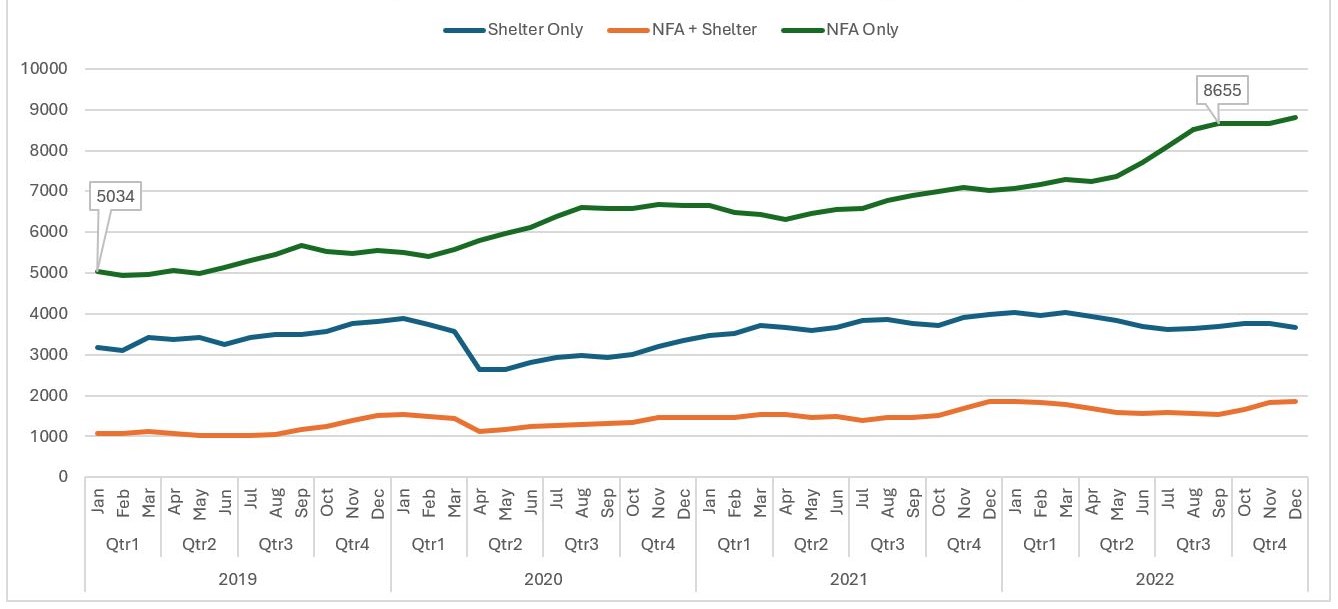Preventing and reducing homelessness: An integrated data project
The Preventing and Reducing Homelessness Integrated Data Project is undertaking innovative analyses of administrative data related to homelessness to better understand, respond to, and prevent homelessness in B.C.
On this page:
Introduction
The Province uses administrative data to estimate the number of people in B.C. who experience homelessness every year. BC Stats, part of the Ministry of Citizens’ Services maintains and updates the Homelessness Cohort research dataset annually. This dataset uses information from three administrative service sources: shelter use, social assistance payments, and demographics from the Medical Services Plan system.
Read more information about the Homelessness Cohort and Method.
Estimates of Homelessness
To date, the Province has used this Homelessness Cohort to get annual estimates of people living in British Columbia who experienced homelessness from 2019 to 2022. Annual Estimates of the Homeless Population in B.C. are included in the Data Catalogue release.
Summaries of these estimates are available in the below dropdown sections.
Annual Homelessness
Annual Estimates of the Homeless Population in B.C. are included in the Data Catalogue release.
The table below shows the homeless estimates in relation to the total provincial population. It is important to note that 2020 was the year of the COVID-19 pandemic. The rate of homelessness has increased over time since 2020.
|
Monthly Homelessness
Monthly estimates are also included in the Data Catalogue release. This data is disaggregated by how individuals were identified in the data.
| Jan | Feb | Mar | Apr | May | Jun | Jul | Aug | Sep | Oct | Nov | Dec | |
|---|---|---|---|---|---|---|---|---|---|---|---|---|
| 2019 | 9020 | 9092 | 9514 | 9505 | 9425 | 9405 | 9767 | 10003 | 10348 | 10332 | 10647 | 10893 |
| 2020 | 10935 | 10633 | 10587 | 9578 | 9790 | 10171 | 10562 | 10879 | 10843 | 10961 | 11347 | 11444 |
| 2021 | 11605 | 11481 | 11689 | 11518 | 11530 | 11721 | 11829 | 12091 | 12128 | 12241 | 12716 | 12856 |
| 2022 | 12983 | 12963 | 13123 | 12867 | 12788 | 12974 | 13307 | 13737 | 13878 | 14081 | 14272 | 14342 |
How individuals were identified as experiencing homelessness has changed over time. While the number of individuals identified fully or in part through access to BC Housing funded emergency shelters has remained fairly stable (and is limited by shelter bed capacity), the number of individuals with no fixed address but no shelter stays has risen steadily since 2019. Of the estimated 9,280 individuals experiencing homelessness in January 2019, the 5,034 individuals identified solely through a no fixed address flag reflected 54% of that estimate. By September 2022 the 8,655 individuals solely identified through a no fixed address flag reflected a peak share of 62% of the estimated 13,878 individuals identified as experiencing homelessness.
Monthly Estimates of Homelessness Over Time (2019-2022)

Research Findings
Using this integrated Homelessness Cohort data and related data available through the Data Innovation Program, the project team looks at how people experiencing homelessness interact with provincial services. The goal is to better understanding how to prevent and respond to homelessness.
Year-Over-Year Flows in Homelessness (2019–2022)
The picture below shows how people move in and out of homelessness each year.

- Outflow means people who were counted as experiencing homelessness one year but were not counted as experiencing homelessness the next year.
- Inflow means people who were not counted as experiencing homelessness one year but were counted as experiencing homelessness the next year.
- Net flow means the change in how many people were counted as experiencing homelessness.
- Continued homelessness means people who were counted as experiencing homeless for two years in a row.
Reference Population
This means people who had a home during the year. It also includes people who:
-
Moved out of the province
-
Didn’t access a shelter
-
Weren’t receiving social assistance help with no fixed address
-
Were deceased
People Counted as Experiencing Homelessness
This means people who either:
-
Stayed at a BC Housing affiliated shelter for at least one night
-
Received social assistance for 3 or more months in a row and didn’t have a fixed address
After an initial decline in homelessness in 2020, net flow of homelessness has increased over time.
Movement of Individuals Experiencing Homelessness (2019-2022)
The number of individuals identified as experiencing homelessness were examined using the administrative data in multiple different Census Divisions in the same calendar year. In B.C., Census Divisions correspond to the Regional Districts (and the unincorporated Stikine Region in the northwestern corner of the Province).
People who were experiencing homelessness and moved between different Census Divisions (regions) during the same year:
|
Year |
2019 |
2020 |
2021 |
2022 |
|---|---|---|---|---|
|
Number of Individuals identified in Multiple Census Divisions |
2,655 |
2,493 |
2,826 |
2,931 |
|
% of Grand Total |
10.7% |
10.2% |
10.7% |
10.2% |
|
Number of Individuals identified in a Single Census Division |
22,062 |
22,013 |
23,550 |
25,779 |
|
Grand Total |
24,717 |
24,506 |
26,376 |
28,710 |
Most people experiencing homelessness stay in one Census Division (region) during the year. Only a small number move between regions, and this pattern has remained fairly stable over time. This matches what people report in B.C. Homeless Counts.
Use of Crisis Intervention Services
This analysis explored the use of “crisis intervention services” in British Columbia by residents of BC Housing funded supportive housing facilities compared to people identified as experiencing homelessness. Rates of emergency department visits, hospital admissions, and incarceration in B.C. correctional facilities were compared.
Across each service, average monthly use rates were lower among residents of supportive housing compared to individuals identified as experiencing homelessness.
- Overview of Findings: Emergency Department Use (PDF, 127 KB)
- Overview of Findings: Hospital Admissions (PDF, 89 KB)
- Overview of Findings: Incarceration Rates (PDF, 100 KB)
Additional information on the analysis is available in the Crisis Intervention Services Methods Document (PDF, 171 KB).
Homelessness Cohort & Method
The Preventing and Reducing Homelessness Integrated Data Project began in 2019 as a partnership between the Ministries of the Attorney General, responsible for Housing (now the Ministry of Housing and Municipal Affairs), Social Development and Poverty Reduction, Citizens’ Services and BC Housing. Its goal was to build a reliable dataset to help the Province better understand, respond to, and prevent homelessness in B.C. In 2024, BC Stats took over the technical work of creating and updating the Homelessness Cohort. Policy-focused research continues to be led by the Preventing and Reducing Homelessness Integrated Data Project.
For the purposes of this work, an individual is considered to have experienced homelessness if at minimum they have:
- Spent three consecutive months on social assistance (BC Employment and Assistance program) with a No Fixed Address (NFA) flag
- Stayed one night in a BC Housing-affiliated shelter; or
- Had both experiences
The data sources used in this project:
- SDPR B.C. Employment and Assistance data
- BC Housing Homeless Individual and Families Information System (HIFIS) Shelter data
- Ministry of Health’s Medical Services Plan (MSP) registry for demographic data
As the cohort relies on administrative datasets to determine homelessness status, it only captures individuals who have accessed the services described above.
Further information on the Homelessness Cohort metadata is available through the Data Catalogue.
Reports Archive
The latest data related to estimates of the homeless population in B.C. is available through the BC Data Catalogue: Annual Estimates of the Homeless Population in B.C.
As the project evolves, data improves over time. As data improves, past numbers may change slightly. Always check and refer to the latest data for the most accurate information.
Previous estimates are available in the following documents:
Archive
- 2019: Annual Estimate Report | Technical Report | Appendix
- 2020: Annual Estimate Report | Technical Report
- 2021: Annual Estimate Report* | Technical Report
*Minor correction to the Total Homelessness count for 2019 in Table 2 on page 7.
BC Stats
BC Stats is the provincial government's leader in statistical and economic research, information and analysis. BC Stats has provided the necessary infrastructure to conduct this research with the Data Innovation Program. Additionally, BC Stats has provided data science capacity and expertise to this project, supporting the generation of annual estimates of the population experiencing homelessness in B.C.
BC Housing
BC Housing: A Crown corporation that supports social housing, affordable housing, rent supplements, emergency shelters and outreach for people experiencing or at risk of homelessness. BC Housing reports to the Ministry of Housing
Ministry of Housing and Municipal Affairs
The Ministry of Housing and Municipal Affairs is responsible for providing British Columbians access to more affordable, safe and appropriate housing through policy and programs, technical codes and standards, and services for landlords and tenants. The Ministry of Housing and Municipal Affairs is responsible for overseeing the implementation of Belonging in BC, the Province’s multi-ministry plan to prevent and reduce homelessness.
Ministry of Social Development and Poverty Reduction
As the Ministry responsible for income and disability assistance, the Ministry of Social Development and Poverty Reduction focuses on providing British Columbians in need with a system of supports to help them achieve their social and economic potential.
